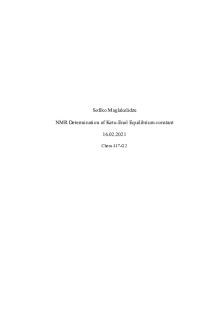NMR pent 1 yne 4 hydroxy r 11d PDF

| Title | NMR pent 1 yne 4 hydroxy r 11d |
|---|---|
| Author | MOHAMED DAHMANE |
| Course | Corporate law |
| Institution | Université des Sciences et de la Technologie Houari Boumediène |
| Pages | 4 |
| File Size | 232.5 KB |
| File Type | |
| Total Downloads | 31 |
| Total Views | 123 |
Summary
nmr spectroscopy...
Description
Problem R-11D (C5H8O) 300 MHz 1H NMR spectrum in CDCl3 Source: Rob Risi/Burke g OH
30 20 10 0
Hz
3.43
D 2.50
2.45
2.40
C 2.35
2.30
2.25
2.20
2.15
2.10
B 2.05
2.00
1.95
1.90
2.13
E 4.00
3.95
1.00
3.90
E
7
6
5
ppm
200 PLT ex-1-2011-12-gq.plt
180
160
3
81.0
Problem R-11D (C5H8O) 75 MHz 13C NMR spectrum in CDCl3 Source: Rob Risi/Burke
4
140
120
ppm
100
80
C B
A
2
1
66.4
8
D
71.0
9
1.3
0.950.96
0
60
40
22.5
4.05
29.2
4.10
20
0
Problem R-11D (C5H8O) IR Spectrum (neat liquid) (Source: Rob Risi/Burke 03/42)
Problem R-11D (C5H8O). Determine the structure of R-10E from the 1H NMR, 13C NMR and IR spectra provided. (a) DBE
(b) What information can you obtain from the IR spectrum (give frequency and peak assignment).
(c) Analyze the 1H NMR spectrum. For each of the groups of signals marked on the spectrum, report the multiplet structure in the standard format (e.g., 0.0 , dtd, J = 0.0, 0.0, 0.0 Hz, 2H) and any part structure you could obtain from the signal(s). A B C D E
(d) Give your answer below. If more than one structure fits the data, draw them, but indicate your best choice by circling the structure
(e) The 13C NMR chemical shifts are listed below. Write the values on your structure. 22.5 29.2 66.4 71.0 81.0 (f) To confirm your assignment (and structure) calculate the chemical shifts of the carbons in your structure assigned to the 29.2 and 66.4 signals. Use a suitable model compound, and appropriate chemical shift values.
25 2
Problem R-11D (C5H8O). Determine the structure of R-10E from the 1H NMR, 13C NMR and IR spectra provided. 2
(a) DBE
(b) What information can you obtain from the IR spectrum (give frequency and peak assignment).
3400 cm-1 O-H stretch 2120 cm-1 CC stretch 3300 H-CC stretch (not very distinct)
4
(c) Analyze the 1H NMR spectrum. For each of the groups of signals marked on the spectrum, report the multiplet structure in the standard format (e.g., 0.0 , dtd, J = 0.0, 0.0, 0.0 Hz, 2H) and any part structure you could obtain from the signal(s). H 1.29, d, J = 6 Hz CH3-C A B C 7
1.93, d, J = 5 Hz
H O-C-H
H C-C-H
2.08, t, J = 3 Hz
H CC CH2 (small coupling)
H
H H
2.34, 2.42, ABXY system, JAB = 17, JAX = 6.6 Hz, JAY = 2.5 Hz JBX = 5 Hz, JBY = 2.5 Hz, D E
Diastereotopic CH2, coupled to two protons, one long range, one vicinal CH2
3.99, Apparent septet, J = 6 Hz (actually dddq, with all coupling very similar in size)
O
H CH3
H
H
(d) Give your answer below. If more than one structure fits the data, draw them, but indicate your best choice by circling the structure Other proposed structures 22.5
29.2
6 71.0
81.0
(e) The
OH
66.4
OH
6 13
OMe
OH
2
2
2
C NMR chemical shifts are listed below. Write the values on your structure. 22.5 29.2 66.4
2
71.0 81.0 (f) To confirm your assignment (and structure) calculate the chemical shifts of the carbons in your structure assigned to the 29.2 and 66.4 signals. Use a suitable model compound, and appropriate chemical shift values. Model H
H
68.2 83.6
4
20.1
20.1 + (OH)-iso = 20.1 + 8 = 28.1 (obs 29.2) (if use "iso" value, don't need branching - already included) OH
22.1 13.1 JMR-76-521
22.1 + (OH)iso = 22.1 + 42 = 64.1 (obs 66.4)...
Similar Free PDFs

NMR pent 1 yne 4 hydroxy r 11d
- 4 Pages

NMR - Riassunto corso NMR
- 3 Pages

Taules NMR
- 3 Pages

NMR tutorial
- 5 Pages

NMR Solvents
- 4 Pages

R B 4 - Derecho civil 1
- 1 Pages

Nmr-booklet-answers - Guuu
- 13 Pages

Second Order NMR
- 7 Pages

NMR Practice Worksheet
- 11 Pages

Practice NMR Orgo 2
- 19 Pages

NMR Laboratory Report
- 17 Pages

NMR-practice 232 final
- 11 Pages

IR NMR Table - chemistry
- 15 Pages
Popular Institutions
- Tinajero National High School - Annex
- Politeknik Caltex Riau
- Yokohama City University
- SGT University
- University of Al-Qadisiyah
- Divine Word College of Vigan
- Techniek College Rotterdam
- Universidade de Santiago
- Universiti Teknologi MARA Cawangan Johor Kampus Pasir Gudang
- Poltekkes Kemenkes Yogyakarta
- Baguio City National High School
- Colegio san marcos
- preparatoria uno
- Centro de Bachillerato Tecnológico Industrial y de Servicios No. 107
- Dalian Maritime University
- Quang Trung Secondary School
- Colegio Tecnológico en Informática
- Corporación Regional de Educación Superior
- Grupo CEDVA
- Dar Al Uloom University
- Centro de Estudios Preuniversitarios de la Universidad Nacional de Ingeniería
- 上智大学
- Aakash International School, Nuna Majara
- San Felipe Neri Catholic School
- Kang Chiao International School - New Taipei City
- Misamis Occidental National High School
- Institución Educativa Escuela Normal Juan Ladrilleros
- Kolehiyo ng Pantukan
- Batanes State College
- Instituto Continental
- Sekolah Menengah Kejuruan Kesehatan Kaltara (Tarakan)
- Colegio de La Inmaculada Concepcion - Cebu


